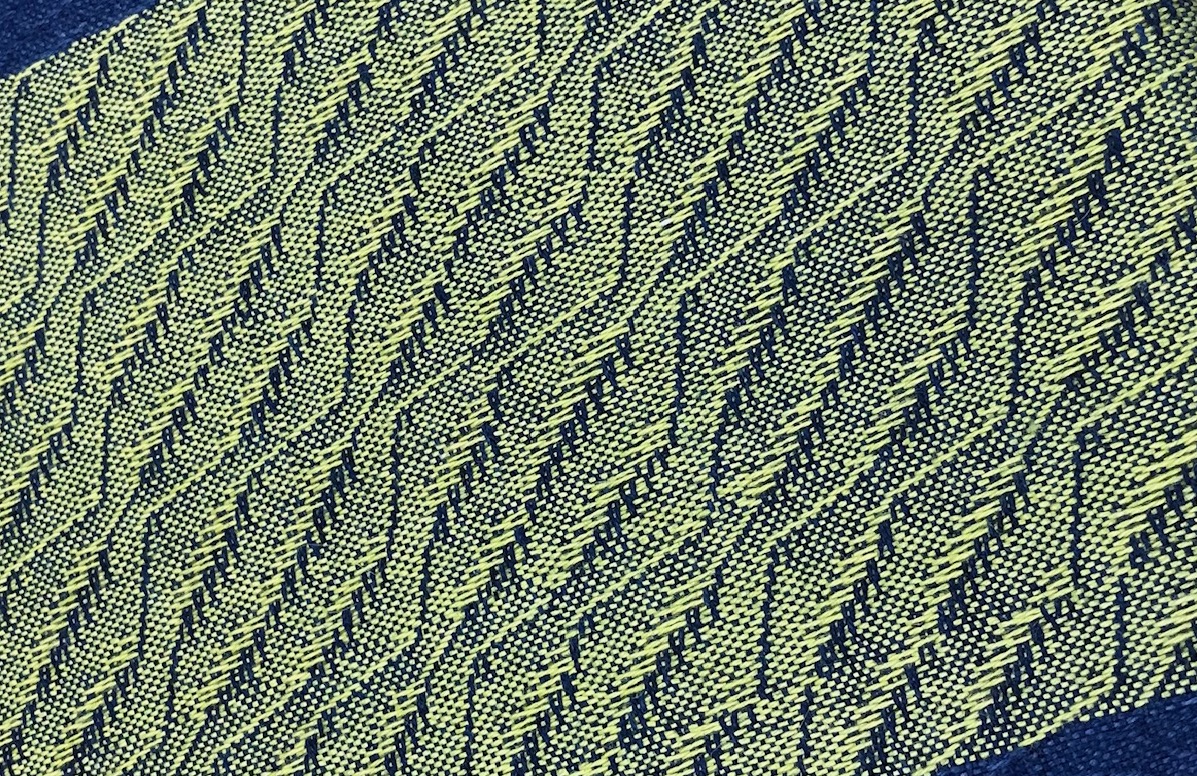
Episode #61
Jo Andrews
Quilting in a flat frame with a rocking stitch has a history that stretches back certainly to the 16th century and maybe much further. This is one of the original forms of quilting, creating beautiful and complex patterns as it is done. This technique often produces a style of quilting known as whole cloth quilts.
Hand quilting in a frame is being placed on the Red List of Endangered Crafts by the Heritage Crafts Council in Britain as the number of elderly practitioners of this skill, mainly in Wales, Northern England and the Scottish Borders continues to dwindle and quilting frames disappear. But here we talk to two quilters who are seeking to reverse that by recognising, protecting and reviving whole cloth quilting, and the tools needed to carry it out.
Notes:
If you want to know more about whole cloth quilting: Jess and Deb’s website is called Within the Frame: https://www.withintheframe.co.uk/
If you want to buy a quilter’s frame here is the link: https://www.loosefit.co.uk/shop/p/hake-quilting-frame
The Haptic and Hue episode about whole cloth quilting was called: Whole Cloth From the Hills: North Country Quilts: Episode #21 https://hapticandhue.com/podcast-episode-21-whole-cloth/
You can see Deb Macguire carrying out the special rocking stitch that has been defined as an intangible cultural heritage in the video Quilt Time, made by Lily Ford about a quilt made in Swaledale in 1890s which is now in the collection of the Quilter’s Guild in York.
The lecture given by Jess and Deb at the Paul Mellon Centre can be found at https://www.withintheframe.co.uk/publiclectures
The Heritage Craft Council can be found at https://www.heritagecrafts.org.uk/ And their Red List is at https://www.heritagecrafts.org.uk/categories-of-risk/
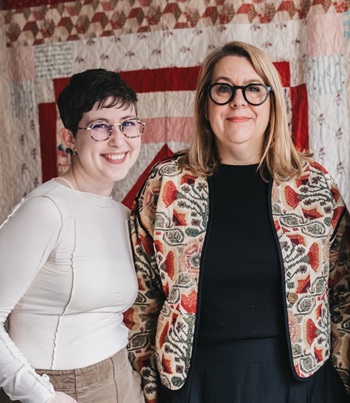
Dr Jess Bailey and Deborah McGuire
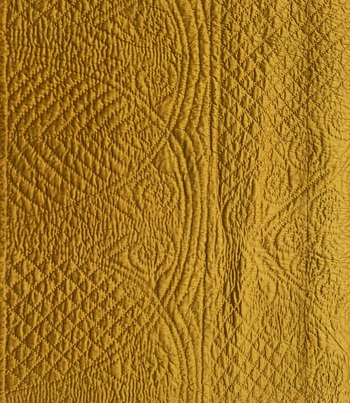
Welsh Quilt Around 1900 Courtesy Within the Frame
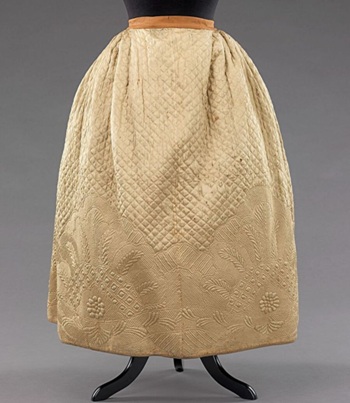
French Quilted Petticoat 1795 Courtesy Metropolitan Museum of Art
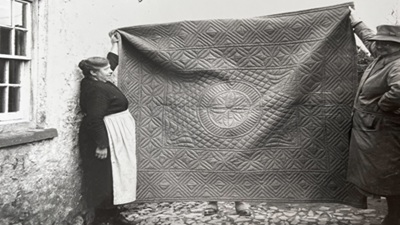
Finished Whole Cloth Quilt 1928 Courtesy Museum of Wales

Jennifer, Eleanor and Mrs C Alderson making a Whole Cloth Quilt, Swaledale 1965, By Kind Permission of the Marie Hartley Estate, Leeds University Library
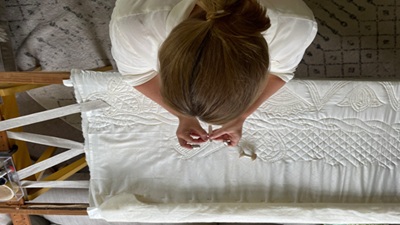
Hand Quilting a Wholecloth Quilt in the Frame Courtesy of Within the Frame
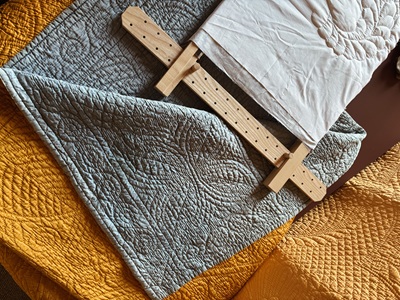
Frame and Whole Cloth Quilts, Courtesy Within the Frame
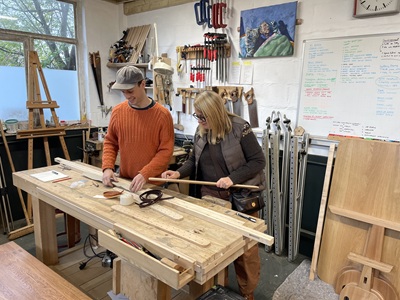
Deb and James During The Hake Quilt Frame Development
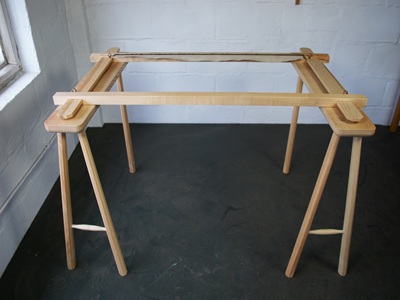
The Hake Quilt Frame and Stand
Script
Reviving Rocking Stitch & Saving Whole Cloth Quilting
Jo: Hello and welcome to this surprise extra episode of Haptic and Hue. I know we said there wouldn’t be a July episode of Tales of Textiles as this podcaster needed a summer break, and there isn’t. This is something a bit different. I’m Jo Andrews and I’m the host of Haptic and Hue. I’m a hand weaver interested in what textiles and their history tell us about ourselves and our communities. As some of you know, as well as running this podcast, we run a separate monthly podcast for Friends of Haptic and Hue. By we, I mean me and Bill Taylor, who’s the editor and producer of Haptic and Hue. It’s called Travels with Textiles, and it gives us a chance to cover all kinds of subjects that crop up in the news or that we come across in our travels and that we don’t get the chance to talk about in the main Haptic and Hue podcast. We thought that this month we’d give you a taste of what the Monthly Friends podcast sounds like. Joining friends cost five pounds a month or 50 pounds a year, and as well as a monthly podcast, friends get a chance to enter the draw for the textile gifts that we give away with every episode. These vary from antique French linen towels or woven offcuts from the Scottish Mills to next month’s giveaway, which are bundles of fabric from the famous London Store Liberties, which is marking its hundred and 50th anniversary. Friends also get 20% off all the textile travel guides that I write with Rebecca Devaney. And there’s a new one of those just out for Edinburgh and the South of Scotland. But the important thing about Friends is that they’re the people who keep this podcast going. We don’t carry advertisements or seek sponsorship because we think there’s just too much of that kind of noise already in our lives. And also, because for us, it’s the story that counts. So, without Haptic and Hue’s Friends the podcast simply wouldn’t exist. We couldn’t afford to fund it out of our own pockets. So, if you are already a member, thank you. We appreciate it enormously, and please know that you make a real difference. If you’d like to think about becoming a member, the place to go is www.haptichu.com/join where you can find out more what follows is May’s, Friends of Haptic and Hue’s episode, it came the day of the announcement from the UK’s Heritage Crafts Council, that two textile crafts linen beetle and quilting in a frame had just gone on the list of crafts that are now critically endangered. Both have been entered onto UNESCO’s Intangible Cultural Heritage List. This episode focuses on how whole cloth quilting got onto the list and what it means for the craft. I hope you enjoy it. And meanwhile, we will be back in September with a brand-new episode of Haptic and Hue. And until then, have a great time and enjoy whatever you are making.
Bill Taylor: Hello and welcome to the latest edition of Travels with Textiles, the special podcast for Friends of Haptic and Hue. I’m Bill Taylor, the editor and producer of Haptic and Hue.
Jo: And I’m Jo Andrews, the host of Haptic and Hue.
Bill: This month we travel in search of a traditional textile craft that has become honoured and endangered, almost in the same breath. UNESCO has just announced that it is adding this old quilting practice to the list of crafts that have intangible cultural heritage status. It’s called whole cloth quilting, and has a history that stretches back certainly to the 16th century and maybe much further. This is one of the original forms of quilting on cloth, creating beautiful and complex patterns as it is done. At the same time as this recognition from UNESCO, wholecloth quilting has also been placed on the red list of endangered crafts by the Heritage Crafts Council. And that’s because the number of elderly practitioners of this skill, mainly in Wales, in Northern England and the Scottish borders continues to dwindle and quilting frames disappear. Joe has been talking to two quilters who are seeking to reverse this by recognizing, protecting and reviving whole cloth quilting and the tools crucially and the tools needed to carry it out.
Jo: This is really the most incredible achievement by Deb McGuire and Jess Bailey. And they have spent 18 months filling out forms and proving to the Heritage Crafts Council. And inevitably behind that UNESCO that whole cloth quilting is something that deserves to go on the endangered list, the red list of crafts. It’s not often that a textile craft gets on that list. So many congratulations to them, and this was announced today as this podcast goes out. So that is fantastic. But many of you will be asking what is whole cloth quilting? And there are really two different skills going on in quilting, and most people perhaps don’t see that because we’ve come to focus on one and not the other. And obviously when we think of a quilt, we think of piecing pieces of material together. And obviously this used to be scrap material, which would make up a patchwork quilt, the patchwork being the top of the quilt. And then you have the bit in the middle, Bill, which is the bit that keeps you warm, which is called the batting and adds weight. And then you have the backing, which is the bit you sleep under, and the whole lot is held together by the quilting stitch. And wholecloth quilting makes very little play of the fabrics that are used for the top. Sometimes that’s just a plain white, but it focuses on what happens with the quilting stitches and what kind of patterns are made with those. And those can be incredibly complex. This is the original form of quilting in Britain, something that was completely functional and very beautiful, and we know we can prove that it dates back to the 1500s. And we also know that it was practiced right up until the 1970s and eighties in those kind of upland areas that you mentioned. But as people get older, as the quilters begin to die out, it too as a practice has been diminishing. And so what Deb McGuire who’s been a whole cloth stitcher of some renowned for many years, and Jess Bailey have done, she’s also a lifelong quilter. They got together and to try to reverse the decline of whole cloth quilting. They’ve done a number of things, and what they have done is registered what’s called rocking stitch in a Flat Frame, which is the technical definition of whole police quilting with UNESCO on its intangible cultural heritage list of crafts. And at the same time, it’s gone on the red list of endangered crafts in the UK. And because it was impossible to get a new quilting frame made in the UK, they have also found someone to make up brand new quilting frames in Britain. So, for the first time in many years, you can commission your own quilting frame. When I spoke to them, I started by asking Deb McGuire how it was that she had ended up as a whole cloth quilter. And here’s her story.
Deb Macguire: I lived in America for a while with my job, and I was surrounded in New England by beautiful quilts. And I thought, I would love to take a quilt home because at that stage, like many British quilters, actually, I thought it was an American tradition, and in my head, having an American quilt I would take home would be this sort of memory of my time in America. So I bid on what I thought was going to be a quilt to take home from my bed. But because I knew nothing about quilts or quilting at that point, the, the terminology was that it was a quilt top. So it was a 1930s, very classic kind of American style, little butterflies, feed sack fabrics. So fabrics reused from kind of keeping grain in and and flour in. So it was really evocative of kind of Americana, and I thought it’d be a lovely thing to take home. And then I spent quite a lot of money on it more than I had. And, and when the quilt came to me, it wasn’t a quilt. The word quilt top just means the top layer. So there was nothing in between and no, no quilting stitches through it. And the thing that I loved already was the quilting stitches. And so, I was heartbroken. And so, when I got back to the UK, I thought, I’ll quilt it. You know this, how hard can this be, <laugh> shocking, a shocking thought as it turned out. So, I managed to, and this was kind of before social media and the early days of the internet, you know, kind of nine 2019 99. And I, I managed to find a local quilt shop, which had a really generous patron. And she basically explained to me what quilting was and how you did it. And sold me a hoop and a pair of thimbles and a spoil of thread. And so, my investment then was very modest. But it did take me two years to quilt that quilt and it became very quickly a complete labour of love. So, I think partly because I was completely unexposed to the world of patchwork, which is most people’s normal route into these sorts of things. So, I had no kind of understanding or even really desire to sow bits of fabric together at that stage. I was purely quilting this quilt. And so therefore my whole kind of immersion was in the really simple production of these stitches quilting stitches. And because I did it for two years, I got quite fast. You know, I had this huge expanse to cover, I was teaching myself. And so, I started kind of seeking out examples of quilts in British museums. I started at the American Museum in Bath because they were American quilts, and I thought there were only American quilts. And then from there I kind of followed this trail, which really at that stage was through libraries and, you know, looking at quilt books. And occasionally a quilt book would mention a quilt in the UK in a collection. I would start trying to find pictures or go and see examples of quilts in the UK. And the more quilts that I looked at, they didn’t look like the quilt I had or the ones in the American Museum. They looked like their own thing. And very often they were whole cloth quilts. And so whole cloth quilts for people who aren’t quilters and were discovering it in the way that I did, they’re basically the quilters quilt. So rather than there being any patchwork at all, they are just an expansive fabric on the top, an expansive fabric on the back and wadding in between. And all of the design and the kind of beauty and the pattern and the complexity comes just from the stitch line. And so it started this real obsession with the quilting that appeared in the past. And the difficulty in accessing that and finding out about it is something that has really fuelled everything else that I’ve done. So, you know, if you ask to see quilts, people show you patchwork, if you ask people about quilting, they talk about patchwork. And I was the person who would go and see a quilt in a museum and then want to look at the back so that I could see what the quilting lines look like. Because I didn’t care about the front, as we would call it today. I cared about the texture. And from that, really everything else has flowed. I had a little blog at that point, and I called it plain stitch, and I called it plain stitch because whenever you go back into kind of old technical books about embroidery and quilting in the past, they always talk about this distinction between embroidery, fancy stitching and plain stitching. And plain stitching was the kind of poor relation. Although there’s a lovely description in, in one book where they talk about it as so plain stitching is not the Cinderella of the needle, for it can do what embroidery never can do. It can hold materials together. And I thought plain stitching is really the magic. How can it be that just this plain functional stitch can create all of this beauty when it appears in these different lines and, and different patterns? And something about the kind of humbleness and the sort of understated ness of the idea that it’s the plain stitch that then creates this kind of sculpture rather than, you know, kind of fancy stitching and all of the kind of baggage that comes with embroidery. And, you know, and kind of stitching in that way. I really like the idea that what I was kind of engaging in was something quite utilitarian, but that the output of that turned into something that was unexpectedly beautiful. And so I think when people think about whole cloth quilts and they think about, you know, their, their role and their place in the kind of, you know, world of, or the history of quilt making, you know, what you are really having to do is think about what those quilts were doing for the people that made them. And I think when you then kind of come to it from that angle, you then end up with this completely different history. And that’s, you know, like what Jess and I have really been you know, kind of started out talking about the idea about quilting as a process is about a thing that you do rather than about a quilt as an object. And once you kind of start following that thread, you end up somewhere really different.
Jo: You do indeed. And Jess, you are a Californian, definitely not a North country British girl. So how on earth did you get involved in this?
Jess Bailey: I come from a quilting family. My father’s family is from the American South, and I grew up under a full bed size, but birth quilt, which three of my great aunts made from family clothes in their trailer homes in the south. And this quilt was hand quilted. And so, I have all of these memories of sleeping under it, spreading it out on my bed, playing with our dog on it. It was a quilt that was very much lived with across my childhood when I came to make quilts as an adult living in the UK I was here for work. I was teaching and I started making quilts. And because of this, you know, intense sense memory of the quilt that I grew up with, the quilt that was made, you know, to emphasize family kinship to me as a little girl, there was sort of no thought in my mind that I would ever machine quilt a quilt, because to me that was not what a quilt was.
Jess Bailey: And so, I started hand quilting the quilts that I was making, being an art historian and being someone, you know, obsessed with the deep past, and also someone who has a, an enduring trust of the past. I think I, you know, started digging into regional archives and, you know, online museum catalogues and flipping through library books as Deb says, you know, and sort of going to these older publications and seeing, you know, starting to see all of these images of mostly women sitting or standing at quilt frames. And I was like, of course, if you’re going to quilts for the bits of time you have around your life sitting on the couch in the evening, your hands are going to become very sore. And of course, people have thought of solutions for this. This is not how one actually does this practice. I think I started looking more for where could I obtain a frame, really found that there was no one making quilt frames in the UK.And while I could find frames for sale in the US from kind of inherited sort of families where there was no more quilter and they were selling the quilt frame, I really, for, for, you know, love of money or anything, could not find a quilt frame in the UK. And eventually you know, was very grateful to come across a young quilter who purchased a quilt frame from a Welsh family. It had been made in that family, she was no longer using it. And so, she was willing to sell me this quilt frame, and I was so excited that I did not ask for measurements. I just said, yes, I wanted, please, I need this. I can’t make another a bed quilt without a quilt frame. And thankfully by, you know, a mere sort of inch of space, it fit in a very small room in my London flat. And I, you know, as Deb was describing, I just sort of fell in love with this, this way of making a quilt where you could really walk up to it, do a few stitches, and then go back to whatever complicated, you know, life reality was happening in the other room. You know, there’s something about a quilt frame that just kind of waits for you to be ready to work at it. It, it sort of never occurred to me to make a quilt in any other way. There’s something about that tactility and that that engagement with your hands at every stage of the process that gives me a, a deep amount of peace in making a quilt.
Jo: Deb, when you started whole piece quilting, this wasn’t quite a dead craft in Britain. And I’m really intrigued as to who your community was of other whole peace quilters. Who were the people out there that you could reach? I mean, you were a mother of young children, were the other mothers of young children. Were there other people in your generation or were you looking to another generation?
Deb Macguire: I was just really lucky because I happened to come across in my kind of local area, the retired curator Margaret Paul Townley, who was the curator at Goldsmiths of their textile collection in the 1970s and eighties and early nineties. And she worked with the embroider Constance Howard, and she’s also an embroider, so, you know, but these were women who were pioneers in kind of taking you know, the understanding of textiles into, you know sort of education and, and museum kind of practice. And someone had given her a quilt frame in the 1970s. It had come from their grandmother in Wales, and she had kept it in her house and attic and, you know, generations had sat there, but she wasn’t a quilter. And she’d come across my work and I’d interacted with her, and she said, you seem like the perfect person to have this quilt frame. And it really was just one of those kind of life changing moments. Actually. It was a, a sort of meeting of minds, but also just this sort of handing over of really a, of a baton. And I took the quilt frame, but she wasn’t a quilter, and there there wasn’t somebody to learn from. And so I went back to those library books, books written in the 1930s, 1950s. They were the first sort of point where women had, you know, access to publishing accounts of domestic making really at that stage. And the women who did that, you know, they were, you know, kind of elite women. So there’s all sorts of issues around the, you know, the, the accounts that they gave us. But what they gave us was this thread, you know, this history. And so by going back to those books, I could learn how to load a quilt frame, but obviously in doing that, I was searching for people making quilts in frames today. And that’s how Jess and I met, because j you know, Jess was the only other person that I could find on the internet in Britain who was working in a quilt frame.
Jo: And you telling me that you two are the last two people working in quilt frames in Britain.
Deb Macguire <Laugh> we’re not. And the whole lovely thing about that is that, you know, everything else that we’ve done since then has been about building this community is finding all the other people who are sitting out there thinking, I seem to be the only person left doing this. And it turns out there’s lots of us and we’re all in our own little kind of connection. So, there are people working within sort of heritage inspired quilting groups, so groups of friends, older women that have been sewing together for a long time in places like Wales. There are older women in places like the north country who still benefited from a kind of transference of this knowledge that, that occurred into the 1970s and the, and the 1980s. I mean, the way we have to kind of think about this is almost like there’s a, a, a kind of thread running through it, like a baton being passed. And the point where there’s not someone there to take the baton is when it gets dropped and it disappears. There’s still this tentative connection going back that we’re still able to make, but only just so that the women who learn from the women who learnt from the women who learnt from the 1900s, those women are, are elderly. Now I’m thinking of a woman who I was speaking to just after Christmas, who she’s now in her eighties, probably in the later part of that decade, and she’s no longer really able to get about very much. And I’ve had the complete pleasure of her sort of telephone relationship with her over the last 18 months as we’ve been exploring this project. And, you know, her health has declined over that period. And so, when we’ve been speaking, you know, she felt like that she had outlived the interest in the skill that she has. And so being able to tell her about these networks, about the work we are doing and about the people who are interested in this and, and talking about how, you know, the, where, where we want to you know, celebrate her work has been so important. You know, we’ve also been talking to the families of quilters who have passed, and that’s also been extremely powerful talking to children and grandchildren of women who, you know, were absolutely celebrated in their time within their family and friend networks, but that never received any kind of public recognition outside of that. And, you know, and that’s also been really powerful. So, for example, we’ve been talking to the, the kind of elderly grandsons of a woman who was a prize-winning quilter in the 1940s. We’ve been able to track down newspaper clippings about her work, and they’ve been, you know, noticeably you know, moved by the fact that people are interested in their grandmother because, you know, this is the difference between public history and private history. People understand within their families and communities and networks that somebody is important and the work they do is culturally important. But unless public history is connected to those histories, then we don’t see what’s important to people. We have a privileged position in the sense that we’re able to come and say, we come from these organizations and we’re reaching out because we want to know about this and we want other people to know about it. You know, it has a really important and powerful effect on how families understand the histories that they’ve been keeping. And it also changes the way that those objects are available to, to, to public history as well. The archive of the woman that we’re talking about whose grandsons we were able to speak to, that archive has been collected by a museum, the Quilted Guild collection now. And, and that is, you know, these cardboard boxes, which effectively came from the loft of somebody’s house that are literally like a kind of sedimentary layers of patterns that go right the way back through the 1950s, the forties, the thirties, into intersperse with all the things that you’d imagine that you would just toss into a box, you know, certificates, prize winning communications about classes. And so, you know, being able to kind of map that back and being able to make sure that those pieces of ephemera but that such important ephemera get taken and and understood as being historical documents is also really important part of the kind of validation, it’s personal, but it’s also public. It’s, it’s institutional that the networks, we, we keep coming back to this saying about, it’s about networks, it’s about people, you know, but what’s really important about those networks is about, it’s about validation. It’s about saying, this was an important skill. It can still be an important skill today. And by, by keeping the technicalities around this, you know, the, the, the tools, the practice, the history, the stories, you know, by keeping those stories alive, then that’s the kind of framework that the, that the skill exists within. And without all of those things, it dies, you know? And so we need, we really need to make sure that people understand the stories but that also that they’re able to access things like tools in order to, to, to, to enact their own place in this kind of succession.
Jo: Yes. That brings me really nicely to the fact that I think we can now buy a quilting frame in Britain, thanks to your and Deb’s work. So if you would very nicely tell me about that, that would be wonderful. Well,
Jess Bailey: You know, as we’ve been saying, the lifeblood of hand quilting is the tools that make it possible, right? Every art form has its incredibly beautifully developed specified tools, and there is nothing like working with the right tool for the job, right? It took us a while and through some luck to purchase quilt frames in the uk and both of our quilt frames come from, you know, families where they were made by someone in the family, or, you know, the local butcher, and then were inherited. And eventually the tool outlived the quilters in that family, and they came to us. But we really wanted to make sure that this key piece of the puzzle, the tools that a quilter needs were much more readily available again in the uk. So we looked through a lot of Deb’s historical research into, well, you know, what were other moments when quilting in a frame was taken up very seriously as a practice that needed to be sustained? We looked a lot into, Elizabeth Hake’s 1937 book: English Quilting, Old and New, which has a wonderful diagram for a quilt frame. And you know, Deb thought really carefully about how could we learn from the really intelligent humbleness of how quilt frames were made, right? That a quilt frame is actually not a complicated thing, it’s not an expensive thing. And you know, what if we took that historical knowledge to a contemporary furniture designer and carpenter? So we found a really wonderful, skilled individual named James Toble, and Deb worked really closely with him in his studio to reconstruct a version of a quilt frame that could be, you know, made for a very reasonable price, and which we could basically get back on the market for quilters to purchase again. So as of today, you can buy a quilt frame in the UK.
Jo:Forgive my ignorance, but if I live in America or Canada or Australia, can I buy quilt frames? There?
Jess Bailey: You can, but I think you might wanna go to James <laugh>. <Laugh> James has really produced a, a very beautiful version of, you know, this core historical object that it really doesn’t need updating. It doesn’t need changing. It’s been like this for hundreds of years, and it’s a very functional, very collapsible, you know, four pieces of wood. And there’s something I think incredibly beautiful about a simple excellently made tool.
Jo: I know how tactile these things can be. My own weaving loom is made of Canadian maple, and I couldn’t imagine being without a weaving loom in the house. It isn’t a home without a weaving loom. And Debs, I know that the best thing of all we’ve kept for last, which is that I don’t know whether to call it a whole piece, quilting, I think is the best word, is now going on to the red list of endangered crafts. And please, could you just say a little bit about that?
Deb Macguire: Well, it’s an absolutely overwhelming announcement to be able to make really for us, because we have spent the last 18 months living and breathing this application. So, we are delighted to announce that the skill has been accepted to the red list of Endangered Craft, which is a UNESCO recognized register of Intangible Culture, which is at risk. And the way that the skill has been defined is rocking stitch in a flat frame. And so, the idea being that what we’re preserving here is the process of making quilts. So, there are lots of people making quilts in lots of other ways, and they’re all really important too. But what sits at the root of this is this specific partnership of the skill of the stitch and the, and the, and the stability of the frame. And when those two things come together, as Jess has described, you know, what this, what we’re really preserving here is the pinnacle. It’s the evolution of how you stitch and then how the tool holds the quilt for you. And those two things together is really the crux of it and what that means for us. Why does that matter? It matters so much to us because we are passionate advocates for this skill, but what we, what we know is gonna mean a lot to other people. And really the whole of this process was really about making sure that there was the structures in place that would mean that it doesn’t take two passionate people who love hand quilting to keep this alive into the next generation. But that the, the organization, the structures the funding, the, the, the, the power, you know, that sits around the, the keeping of these things alive was in place for our skill. The, the red list means that you are then able to, or people who are interested in using these skills and developing these tools are able to access things like funding. They’re able to access networks. So, one of the things that they asked us to do was to, to to what does thriving look like? You know, what does a skill that is thriving look like? And obviously that’s led us into things like, you know, creating the frames. It’s also led us to you know, wonderful trips to places like small flock mills where we’ve been looking at, you know, the texture of wool. Because, you know, the other thing about the frame, which is so important is that it’s ecological. It allowed people to use all different substrates of, of fabric. It allowed them to use wool that hadn’t been processed. So modern quilters are re reliant on all of these sorts of processes that happen to the fibres that they use in order to make it possible to quilt without a frame. If you put the frame back in, you take away the need for all of the additional processes that mean that things have to get shipped and you know, things done, done to them in factories, et cetera. And instead it connects quilters back to the land and the place where they are. Use your scraps, visit your farmer, you know, collect some wool from a barb wire fence. It was as simple as that. And it can be as simple as that again, and of course, not everybody is going to choose to quilt in that way, but the freedom to have that as part of your practice is so important to this. It also gives visibility, viability and we really hope that you know, what we’re doing with this work. It’s called Heritage Crafts, the organization that create the red list. But the heritage ness is really just about giving the freedom to modern makers today to understand from the past and then reinvent these skills. You know, Jess and I both work with young people, you know, we work with people who are really creative and you know, what we want them to be able to do is to continue this craft on, you know, what we’ve been describing is something which evolved and changed over time. A whole cloth quilt did not look the same in 1930 as it did in 1850 as it did in 1700. These were people creating new ideas and making new interpretations of the craft. And what the Heritage Craft Red List will enable people to do is to continue that process. Young makers, artists, people wanting to make this skill commercial. Again, they’ll all have access to skills, advice and funding that will enable them to develop that practice. And so, whilst we are historians and art, his historians we’re interested in the past, what we’re really interested in doing is, is connecting people to the past in order to make the future, you know, what does the future look like? And we really want this red listing to enable people to explore ways to use the practice to think about the kinds of values that quilting was associated with in the past as well. You know, when we think about quoting in the past, it’s about commonality. It’s about creativity without a lot of commerce. And it’s about care and kind of care practices, community care, family care people working together with friends and neighbours and community groups. And I think, you know, when we return the modern creativity of quilting back to the same sorts of tools and processes in the past, what also comes with that is all of those kind of care values. And so what we hope is that people are able to use the frames, use the funding, find ways to come together and reconvene around the quilt frame in ways that build community that are careful of the environment, you know, that enable people to make quilts in ways that support all of the connections that quilts are really just the manifestation of, you know, when we think about a quilt as an object, and we talked at the beginning about quilters and not quilts, when we think about a quilt as an object, all it’s really doing is telling us about this huge iceberg beneath it, which is about networks and friendships and family and your neighbours, and the place where you live and your care of the land and the objects that you make and how they pass through generations. You know, these are all about much bigger things than just the practices of making, but those practices of manifestations of our emotional world, aren’t they? And what we really hope is that if people are making quilts again in the future using these tools and in these ways, that we also get to do some work in that area too.
Jo: Jess, where do you hope this will lead? And what would you like the listeners to do?
Jess Bailey: I really hope that this will lead to sustainable intergenerational knowledge transfer at the level of the hand, but also at the level of the intellect. And combining those two things, right, the mind and the hand in terms of, you know, if we sustain intergenerational knowledge transfer around the material and physical skill of hand quilting, we also draw out those histories from those communities, from those families, right? And we shift the priorities then of whose histories we’re writing down and telling and whose knowledge gets valued as authoritative and meaningful in a historical record, right? So I see this as a way forward for both of those things, how we write history and how we make quilts to that. I would really love if listeners would go and enjoy a recent lecture, which Deb and I gave together. That’s available for free on YouTube and you can find it via our website, which is within the frame.co.uk. There’s a lot of different resources there, both for the history of quilting the practice of hand quilting, and of course links to the Hague quilting frame from James, if you would like to order a quilt frame. But on one of our resource pages is this recent lecture, which Deb and I gave together at the Paul Mellon Center for British art. It’s Yale Center for the Study of British Art here in the UK. And they run wonderful public programming and lectures. And we recently gave a history lecture about quilting in the UK and I think it shares some of these really rich histories, family histories, community histories from Wales and the north country especially. You know that lecture has many of the images that Deb and I were referencing about, you know, quilters sitting at frames, working at frames. So, I really encourage everyone to go find that recent lecture via our website within the frame.
Jo: Thank you both very much. It was lovely to talk to you both. You can find details on how to buy your own handmade quilting frame from James Toble and links to Jess and Deb’s website, which is called Within the Frame, as well as pictures of some of the antique quilts and quilters of days gone past on the webpage for this episode of Friends of Haptic and Hugh. I should also say that we did make an episode of Haptic and Hugh, which looked at the entire background and history of whole cloth quilts, and that’s called Whole Cloth from the Hills North Country Quilts. And it’s episode 21, if anyone is interested in having a listen to it.
Bill: Whole Cloth from the Hills that has a certain poetic resonance about it, Whole Cloth from the Hills. A little taste now of what’s coming up in the coming months on the Haptic and Hug podcast, and until of textiles, thanks to you and your ideas, our dear listeners, our travels get ever more exotic and from my point of view, ever more interesting coming up is the truly astonishing story of how a newly commissioned tartan is being used to memorialize, to remember, and to celebrate the thousands of women who were tragically executed and harassed as witches in not only the history of Scotland, but crucially in the history of the USA. And that is an astonishing story. And very shortly, a couple of days after recording this tales of textiles, Joe and I are off to Denmark and Norway. And among the things there, we’ll be looking at the Centre for Textile Research in Copenhagen, and we’ll be exploring the idea of why it is that indulging in craft practicing craft might be very healthy for us, very good for our brains, very good for our whole neurological functioning. And craft practitioners just have known this in their gut and crucially in their hands for all of their lives, I suspect. And we’re often Norway to what is thought to be the wettest place in Europe, Bergen to catch up with some research about how people in the Arctic used a whole range of to my mind, bizarre textiles to keep dry and to keep warm. So, watch this space for these exciting stories, and thanks again for all of your wonderful ideas. Please keep listening and I hope that wherever you are your love of textiles keeps you warm and happy and hopeful,.
Jo: And enjoy whatever making you are doing at the moment. It’s goodbye from me
Bill: And it’s goodbye from me.

